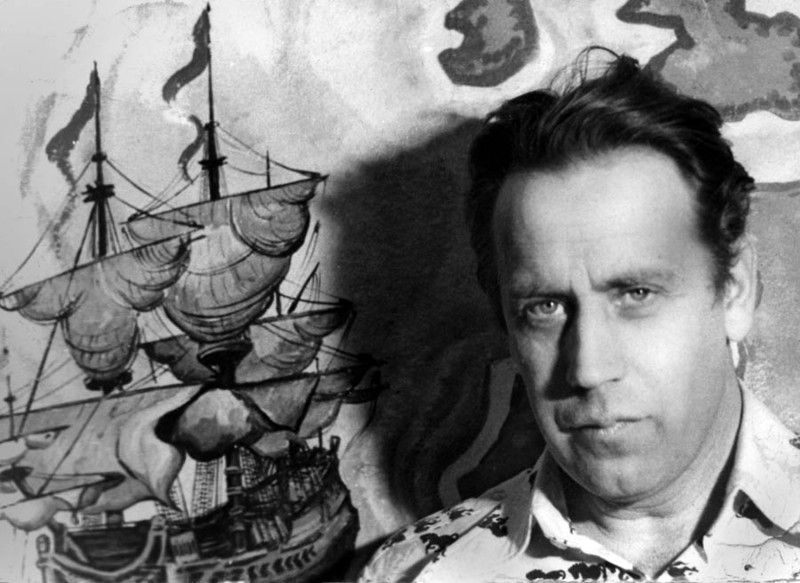Quantum entanglement on the scale of our world or the providence of Vladislav Krapivin
There is such a writer Vladislav Krapivin, he writes books that are very different, someone learns to read from them, and someone already in adulthood returns to his childhood. Mom read them aloud to me when I still could not. In these books there is a lot of science fiction, which subtly echoes the phenomena that are on the border of science and dreams. So often it happens - da Vinci, Jules-Verne, Bradbury - foresaw such inventions and scientific breakthroughs that none of their contemporaries could think of. In several stories, Vladislav Krapivin mentions such items that are one whole, and at the same time copied in a special way - for example, sheets of a notebook, which happened to be in the adjacent space, or an old map of the Guadeloupe island reproduced by boys on a special printer. You write on such, or you pierce, for example, and at the same moment the same changes appear on all the “copies”. Those who have repeatedly read here and in other sources about the phenomenon of quantum coupling probably grunted. The stories I’m talking about were written long before they started talking about this phenomenon. One can argue a lot that when there is no quantum information in transmission, only the quantum state of the object is clarified, but this is almost the same, you just need to learn how to use it correctly. Let me understand little in quantum physics, but the facts, published last week in the journal Scince, inspire me with optimism, read for yourself:

')
This event is the first case in the world when quantum cohesion of rather large objects was obtained, and most importantly, at room temperature.
Let me remind you that quantum coupling is the process of “connecting” two separate material things, be they photons or nanoscale objects, in such a way that the impact on one of the objects appears on the second connected object, regardless of the distance separating them. A change in the state of one bound particle immediately leads to a change in the state of the second particle, even if they are located at different ends of the Universe.
Researchers at the University of Oxford took two diamond crystals, measuring 3 by 3 millimeters and about a millimeter thick. Both crystals were illuminated with short, about 100 femtoseconds, flashes of laser light. The same method is used when conducting spectroscopy with ultra-fast laser pumping (ultra fast pump probe spectroscopy). What then happened to diamond crystals is quite difficult to describe in simple language. The pulses of laser light caused the diamond crystal lattice to vibrate. These oscillations are known in physics as phonons, quanta of oscillations of atoms of the crystal lattice. One pulse of laser light excited two phonons in two diamond crystals and produced two photons of light, which were coupled using fairly traditional methods. It turned out that by coupling two photons at the quantum level, scientists obtained quantum coupling of phonons, vibrations of carbon atoms of diamond crystals.
During the experiments, these two diamond crystals separated the distance of about 20 centimeters, but all changes in the quantum state of one crystal immediately reflected on the state of the second crystal. The quantum coupling of phonons in these crystals lasted a very short time, about 7 picoseconds. This time is too short to use this phenomenon in quantum computing and communications. At least until scientists find a way to increase this time to acceptable values.
Original Source: Researchers Two Millimeter-Sized Diamonds Researchers, A Scale of Quantum Entanglement
In the photo - Vladislav Krapivin

')
This event is the first case in the world when quantum cohesion of rather large objects was obtained, and most importantly, at room temperature.
Let me remind you that quantum coupling is the process of “connecting” two separate material things, be they photons or nanoscale objects, in such a way that the impact on one of the objects appears on the second connected object, regardless of the distance separating them. A change in the state of one bound particle immediately leads to a change in the state of the second particle, even if they are located at different ends of the Universe.
Researchers at the University of Oxford took two diamond crystals, measuring 3 by 3 millimeters and about a millimeter thick. Both crystals were illuminated with short, about 100 femtoseconds, flashes of laser light. The same method is used when conducting spectroscopy with ultra-fast laser pumping (ultra fast pump probe spectroscopy). What then happened to diamond crystals is quite difficult to describe in simple language. The pulses of laser light caused the diamond crystal lattice to vibrate. These oscillations are known in physics as phonons, quanta of oscillations of atoms of the crystal lattice. One pulse of laser light excited two phonons in two diamond crystals and produced two photons of light, which were coupled using fairly traditional methods. It turned out that by coupling two photons at the quantum level, scientists obtained quantum coupling of phonons, vibrations of carbon atoms of diamond crystals.
During the experiments, these two diamond crystals separated the distance of about 20 centimeters, but all changes in the quantum state of one crystal immediately reflected on the state of the second crystal. The quantum coupling of phonons in these crystals lasted a very short time, about 7 picoseconds. This time is too short to use this phenomenon in quantum computing and communications. At least until scientists find a way to increase this time to acceptable values.
Original Source: Researchers Two Millimeter-Sized Diamonds Researchers, A Scale of Quantum Entanglement
In the photo - Vladislav Krapivin
Source: https://habr.com/ru/post/134408/
All Articles